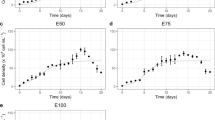Summary
Eicosapentaenoic acid (EPA) volumetric productivity from an outdoor chemostat culture ofPhaeodactylum tricornutum UTEX 640 in a 50-l tubular photobioreactor varies with dilution rate, reaching a maximum of 47.8 mg l−1 d−1 at D=0.36 d−1. Continuous culture at high dilution rates' is proposed as the most adequate operating mode to maximize polyunsaturated fatty acid production.
Similar content being viewed by others
References
Caperon, J., and Meyer, J. (1972).Deep-Sea Research 19, 601–618.
García Camacho, F. (1991). Estudio cinético y composición bioquímica deTetraselmis spp. Análisis de la productividad en un fotobiorreactor externo. Ph. Thesis. University of Granada. p. 351.
Hansman, E. (1973). Pigment analysis. In:Handbook of Phycological Methods, Culture Methods and Growth Measurements, J.R. Stein, ed. pp. 359–368. Cambridge: Cambridge University Press.
Herzig, R. and, Falkowski, P.G. (1989).J. Phycol. 25, 462–471.
Kaixian, Q., and Borowitzka, M.A. (1993).Applied biochemistry and Biotechnology 38, 93–103.
Kates, M. (1986). Techniques of lipidology: isolation, analysis and identification of lipids. 2nd revised edition. In:Laboratory techniques in biochemistry and molecular biology R.H. Burdon and P.H. van Knippenberg eds. vol. 3, part 2, pp. 190–195, Amsterdam. Elsevier Science Publishers.
Lepage, G., and Roy, C. (1984).Journal of Lipid Research, 25, 1391–1396.
Lowry, O., Rosebrough, N., Farr, A., and Randall, R. (1951).J. Biol. Chem. 193, 265–275.
Molina Grima, E., Sánchez Pérez, J.A., García Camacho, F., García Sánchez, J.L., and López Alonson, D. (1993).Applied Microbiology and Biotechnology 38, 599–605.
Molina Grima, E., Sánchez Pérez, J.A., García Camacho, F., Fernández Sevilla, J.M., and Acién Fernández, F.G. (1994a).Applied Microbiology and Biotechnology 41(1): 23–27.
Molina Grima, E., Sánchez Pérez, J.A., García Camacho, F., Fernández Sevilla, J.M. and Acién Fernández, F.G., and Urda Cardona J. (1994b).Applied Microbiology and Biotechnology (in press).
Radwan, S.S. (1991).Appl. Microbiol. Biotechnol. 35, 421–430.
Siron, R., Giusti, G., and Berland, B. (1989).Marine Ecology Progress series 55, 95–100.
Whyte, J.N. (1987).Aquaculture 60, 231–241.
Whyte, J.N. (1988).Aquaculture 75:193–203
Yongmanitchai, W., and Ward, O.P. (1992).JAOCS 69(6), 584–590.
Author information
Authors and Affiliations
Rights and permissions
About this article
Cite this article
Grima, E.M., Pérez, J.A.S., Camacho, F.G. et al. Effect of dilution rate on eicosapentaenoic acid productivity ofPhaeodactylum tricornutum utex 640 in outdoor chemostat culture. Biotechnol Lett 16, 1035–1040 (1994). https://doi.org/10.1007/BF01022399
Issue Date:
DOI: https://doi.org/10.1007/BF01022399




